.
Pano Lefkara (Πάνω Λεύκαρα ) is a municipality of the District of Larnaca
| Year | Population |
| 1946 | 2603 |
| 1960 | 1771 |
| 1982 | 1079 |
| 1992 | 971 |
| 2001 | 921 |
Lefkara (Greek: Λεύκαρα) is a village on the island of Cyprus famous for its lace, known as lefkaritika, and silver handicrafts.
The village takes its name from the white of its silica and limestone: Lefkara is derived from the Greek works lefka ori, white mountains.
It is located on the southern slopes of the Troodos Mountains in the Larnaca District of Cyprus, off the main Nicosia/Limassol highway. Featuring cobbled streets and picturesque architecture. Administratively the village is split into two parts : Lower and Upper Lefkara (Πάνω & Κάτω Λεύκαρα), with around 1,500 inhabitants.
Groups of women sit in the narrow village streets working on their fine embroidery, as they have for centuries. The village is also known for its skilled silversmiths who produce fine filigree work, and there is a small Turkish Delight factory. A folklore museum in the town shows visitors what life was like on Cyprus a hundred years ago. The museum is sited in a restored house and exhibits the furniture and effects of a wealthy family of the time, local costumes and examples of the Lefkara lacework.
According to legend, Leonardo da Vinci visited the village in 1481, and purchased a lace cloth for the main altar of the Duomo di Milano. The lefkaritika style was probably imported there in antiquity from Assyria. Much later, the Venetians brought it home, and set up their own lace industry on the island of Burano. In 1889 a local lace school was opened, and Lefkara lace regained much of its ancient renown.
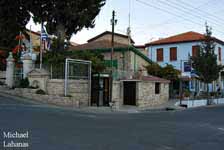
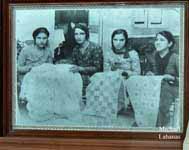
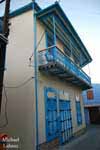

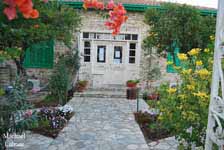
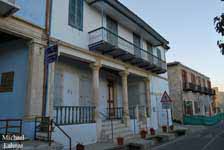

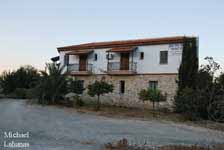
History
Antiquity to the end of the Ottoman Period
The Neolithic archaeological remains found in the village are proof that the region around Lefkara has been inhabited uninterruptedly for centuries. The first historical testimony of the existence of Lefkara with its present-day name is found in the testament of Saint Neophytos, born in 1134 in the village of Kato Drys near Lefkara, when Cyprus was part of the Byzantine Empire. The house (single room) where Saint Neophyte met with his wife-to-be the night before he run away to become a monk, still stands. It is now part of a newer house build around it. The house is now unoccupied and owned by Mrs. Maritsa Kallou.
During the Frankish and Venetian period (1193-1483) Lefkara became a fiefdom. In the 16th century, it was the largest town in Cyprus. From 1571 to 1878 Cyprus was occupied by the Turks. Most of the houses conserved today in the village date from this period. The bare stone façades with few openings, the layout of rooms around an inner courtyard and the flat rammed-earth roofs are typical elements of the architecture of Lefkara up until the late 19th century.
British Occupation and Independence
In 1878 Cyprus became a British colony. Starting in the early 20th century, the commercialisation of local embroidery sold all over Europe by the people of Lefkara produced major changes. Dating from this period are the two-storey houses with shops on their ground floors, sloping ceramic tiled roofs and long balconies running the length of main façades rendered in coloured plaster and decorated with period neoclassical architectural elements.
World War II interrupted the sale of embroidery, which never recovered. The shortage of work forced inhabitants to emigrate en mass and in the 1930s half of the village of Lefkara was uninhabited.
In 1960 Cyprus finally gained independence. Tourism began to develop in the 1970s, saving Lefkara from economic ruin. With traditional architecture still intact, embroidery and artisan silverwork attracted tourists.
Problems Facing the Town
The development of tourism has had positive and negative consequences for traditional architecture. The economic relief brought by tourism has allowed the inhabitants to rehabilitate their homes. In the 1960s and 70s, some old houses were demolished and replaced by modern constructions. The use of new materials chosen for reasons of comfort and fashion has changed the façades and interiors of traditional dwellings. Finally, there are a number of dwellings that have remained untouched and are now closed up and uninhabited. A sad example is the houses of the Turkish Cypriots of Lefkara, abandoned at the time of the Turkish invasion in 1974 as a result of the forced separation of the two communities.
Work to Conserve Architectural Heritage
Numerous traditional houses have been listed by the Department of Antiquities and the Department of Housing and Urbanism. Since 1978, several buildings have been rehabilitated by the Department of Antiquities, most particularly the Patsalos residence, which has been converted into a local museum of embroidery and traditional silverwork. A rehabilitation decree issued by the Department of Housing will include all traditional buildings pending listing.
Lefkara Vetch, flower, (astragalus macrocarpus lefkarensis)
Links
Lefkara Lace embroidery and silver handicrafts
Images Cyprus, Larnaca District

| Ancient Greece
Science, Technology , Medicine , Warfare, , Biographies , Life , Cities/Places/Maps , Arts , Literature , Philosophy ,Olympics, Mythology , History , Images Medieval Greece / Byzantine Empire Science, Technology, Arts, , Warfare , Literature, Biographies, Icons, History Modern Greece Cities, Islands, Regions, Fauna/Flora ,Biographies , History , Warfare, Science/Technology, Literature, Music , Arts , Film/Actors , Sport , Fashion --- |
Retrieved from "http://en.wikipedia.org/"
All text is available under the terms of the GNU Free Documentation License

